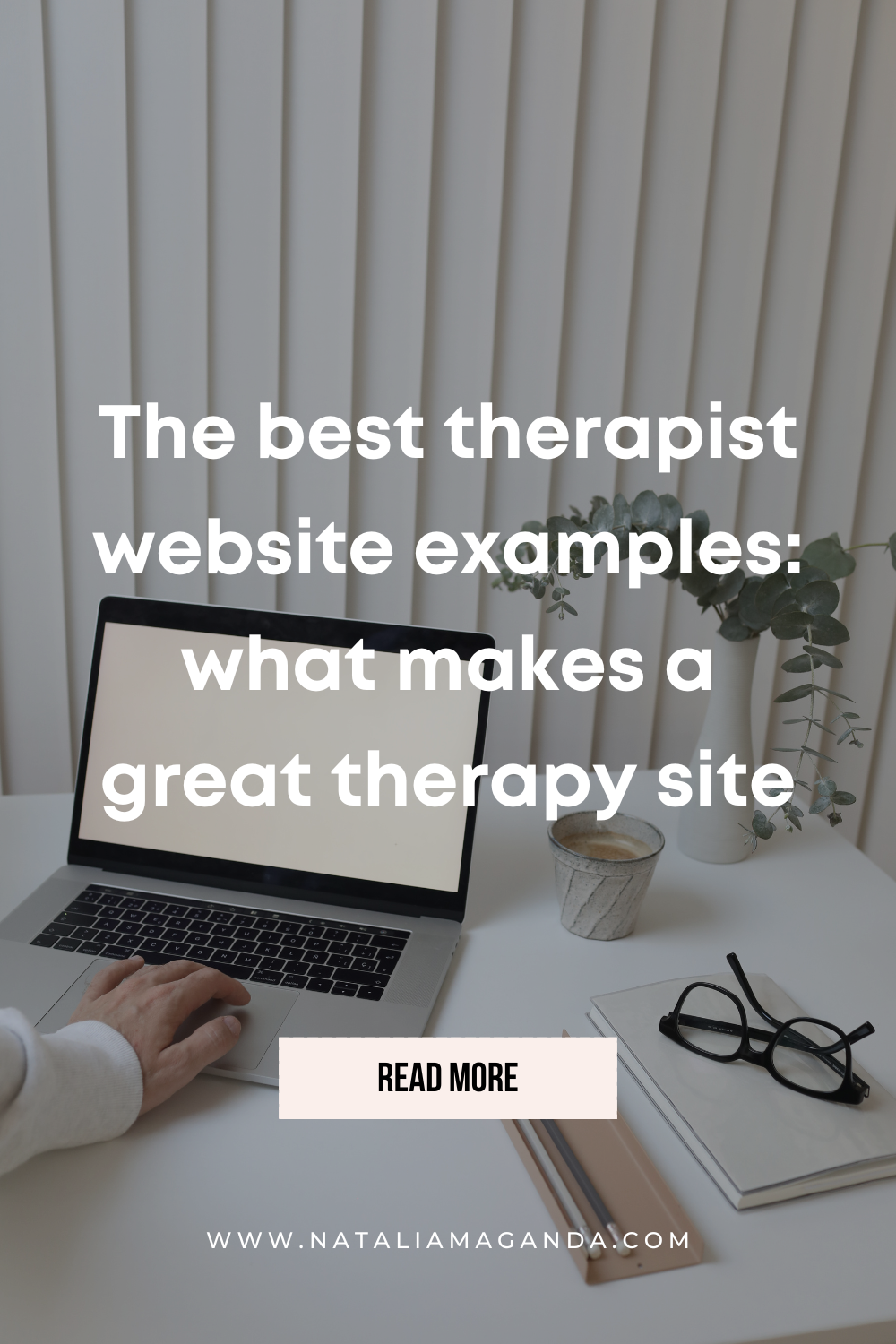The best therapist website examples: what makes a great therapy site
Your website is more than a digital business card—it's your client's first step toward healing
Picture this: A potential client is searching online for a therapist. They’re overwhelmed, hesitant, and maybe even a little skeptical about whether therapy is the right step for them. They type “therapist near me” into Google, click on a few links, and land on your website.
What happens next determines whether they feel safe enough to book a session or click away in seconds.
Your website isn’t just a place to list your services; it’s the first impression, the first connection, and often the first step in someone’s healing journey. A well-designed therapist website can make the difference between a visitor scrolling past and a client booking a session.
But what makes a great therapist website? What should you include? And most importantly, how do you ensure that your website truly reflects you and the work you do?
In case we haven’t met yet, I’m Natalia, a website designer for therapists. I help private practice owners like you amplify their magic, gain visibility, and simplify their marketing efforts through strategic web design and SEO content.
This blog will walk you through everything you need to create a high-converting, client-centered website that doesn’t just look good but actually works for you.
What makes a therapist website different from a standard website?
A therapist’s website serves a unique purpose—it’s not just a portfolio or a business site; it’s a space where people should feel safe, reassured, and encouraged to take action.
While a traditional business website might focus on selling a product, a therapist’s website is about building trust and fostering a sense of connection.
Here’s what makes it different:
- Emotional connection: A client’s decision to book therapy is deeply personal. Your website needs to feel warm, safe, and inviting—like a space where they can open up.
- Clear, empathetic messaging: Unlike a standard service-based business, your site should use compassionate, non-salesy language that resonates with clients' emotional needs.
- Easy access to essential tools: Clients should be able to book an appointment, fill out forms, or ask questions without stress or confusion.
Your website isn’t just about looking professional; it’s about guiding potential clients from uncertainty to action with ease.
Essential tools for a therapist's website
Integrated calendar for effortless session scheduling
Imagine this: someone finds your website after weeks—maybe months—of considering therapy. They feel connected to your words, your energy, your presence. But when they’re finally ready to reach out… they see a contact form, or an email link, or a vague “Call to book.” That small pause can be all it takes for doubt to creep in.
Now imagine a different experience. They land on your site, feel grounded, and immediately see a button that says “Book a Free Intro Call.” No waiting. No follow-ups. In just a few clicks, they’re scheduled for a session—at a time that works for them.
That ease? It’s not a coincidence. It’s strategy. As part of our custom website design, we install an all-in-one CRM system built for therapists that includes a fully integrated calendar. This tool doesn’t just help clients book sessions—it creates a seamless, welcoming experience from the first moment.
We customize it to match your workflow and your energy:
- Automatic appointment confirmations
- Text and email reminders to reduce no-shows
- Pre-session intake forms and booking questions
- Real-time availability that keeps your calendar in sync
Instead of juggling multiple tools or doing manual follow-ups, you get a system that works for you—and for your clients. The result? Less admin, more presence, and a website that becomes a true extension of the care you offer.
Automated reminders to reduce no-shows
Life gets busy, and sometimes clients forget their appointments. Automated reminders via email or text can reduce no-shows, helping both you and your clients stay on track without extra administrative work on your end.
What makes a great therapist website?
While much of this blog has focused on common mistakes, it’s just as important to name what should be included when building an effective, aligned, and high-converting therapist website.
When I design websites for therapists, I don’t just focus on aesthetics—I design with strategy, clarity, and user experience in mind. Your website should walk visitors through an emotional journey: from feeling unsure and overwhelmed, to feeling grounded, seen, and ready to take the next step.
Here’s what every therapist website should include to support that journey:
- Home page: This is your digital front porch. It should clearly communicate who you help, how you help, and guide users toward their next step. This is where emotional connection begins.
- About page: People choose therapists they feel they can trust. Your story matters. A well-crafted About page helps potential clients feel safe and connected to your unique voice, values, and approach.
- Service pages: Don’t just list your services—explain them. A good service page outlines who the offering is for, what transformation it leads to, and what’s included in the experience.
- Contact page or inquiry form: Make it easy to get in touch. A clear, concise contact page or embedded inquiry form builds trust and reduces friction.
- Integrated scheduling: No more email tag. A scheduling tool that allows clients to book intro calls or sessions instantly is key to conversions. (We include a fully customized system when we build your site—read how it works here.)
- SEO-optimized copy: Your site should be written with intention
and searchability in mind. From headers to meta descriptions, every word should help clients find you on Google.
- Blog or resource library: This is your space to educate, connect, and showcase your voice. Blogs also strengthen your SEO and help clients build trust before they even reach out.
- Testimonials or social proof: Sometimes, clients need to hear from others to feel confident in taking that first step. Testimonials validate your work and build credibility.
- Mobile responsiveness: More than half of your website traffic will come from phones. Your design needs to be beautiful
and functional on every screen size.
- Accessibility elements: From readable fonts and contrast ratios to alt text for images and screen-reader-friendly layouts—your site should be inclusive.
If your current website doesn’t check all these boxes, don’t worry. These are exactly the foundations I help therapists build from the ground up. The result? A website that feels aligned with your energy and supports your goals—without the tech overwhelm.
What mistakes should you avoid in your website design?
Lack of clarity in navigation and structure
Your website should feel like a calming space, not a maze. If visitors can’t quickly find essential information—who you are, how you help, and how to book a session—they’ll leave. A simple, clean structure with clear menu navigation is key.
Not including clear calls to action (CTA)
Imagine someone who’s unsure whether to start therapy finally lands on your website. They’re curious but hesitant. If your site doesn’t guide them on what to do next—whether it’s scheduling a consultation, reading a blog, or learning about your approach—they might leave without taking action.
Every page should have a clear CTA guiding visitors toward the next step.
Not optimizing for SEO: how to avoid losing visibility on Google
You could have the most beautiful website in the world, but if no one can find it, what’s the point? SEO (search engine optimization) helps your site rank on Google, so when someone searches for a therapist in your area, your website actually shows up.
Not sure where to start? Read more about SEO for therapists.
Ignoring accessibility: making your website inclusive
for everyone
Your website should be easy to use for all clients, including those with disabilities. This means ensuring readable fonts, color contrast for visibility, alt text for images, and screen reader compatibility.
How to optimize your website to attract more clients
SEO for therapists: how to rank your website on Google
SEO isn’t just about ranking—it’s about getting the right clients to find you. Targeting location-based keywords like “anxiety therapist in [your city]” or “online therapy for trauma” can make a huge difference in bringing in clients actively searching for support.
The importance of valuable content: blogs, resources, and articles
A blog isn’t just a way to boost SEO; it’s a way to connect with potential clients before they ever reach out. Writing about common struggles, therapy techniques, or answering FAQs builds trust and positions you as an expert.
Want to know how to structure a blog for your practice and make sure people actually find it? Start by understanding your SEO. Read this blog to learn how to find the best keywords for your therapy site—and what tools to use to do it with ease.
Strategies to convert visitors into potential clients
Having website traffic is great, but how do you turn visitors into actual clients?
Some strategies include:
- Offering a free consultation call
- Providing downloadable resources (like a self-care checklist)
- Using testimonials to build trust
- Making your contact page easy to find
Examples of successful therapist websites
Here’s where inspiration meets action. These therapist website examples showcase beautifully designed, functional, and high-converting therapy sites. Take a look at what’s working and see how you can apply these best practices to your own website.
How can I help you build an effective website?
Your website isn’t just about aesthetics—it’s a tool that should work for you, helping you book more clients, streamline your processes, and create a welcoming online presence.
If you’re ready to have a high-converting website that reflects your unique therapy practice, I can help. Let’s create a site that makes your potential clients feel seen, heard, and ready to take the next step.
Explore my web design services for private practice professionals and therapists here.

* AI Disclosure: This content may contain sections generated with AI with the purpose of providing you with condensed helpful and relevant content, however all personal opinions are 100% human made as well as the blog post structure, outline and key takeaways.
* Affiliate Disclosure: Some of the links on www.nataliamaganda.com may contain affiliate links meaning that I will get a commission for recommending products at no extra cost to you.

hello! i'm natalia
Latina, web design expert for mental health professionals.
I help ambitious life coaches, therapists and holistic leaders amplify their magic, gain visibility, and simplify their marketing efforts through strategic web design and content.




























